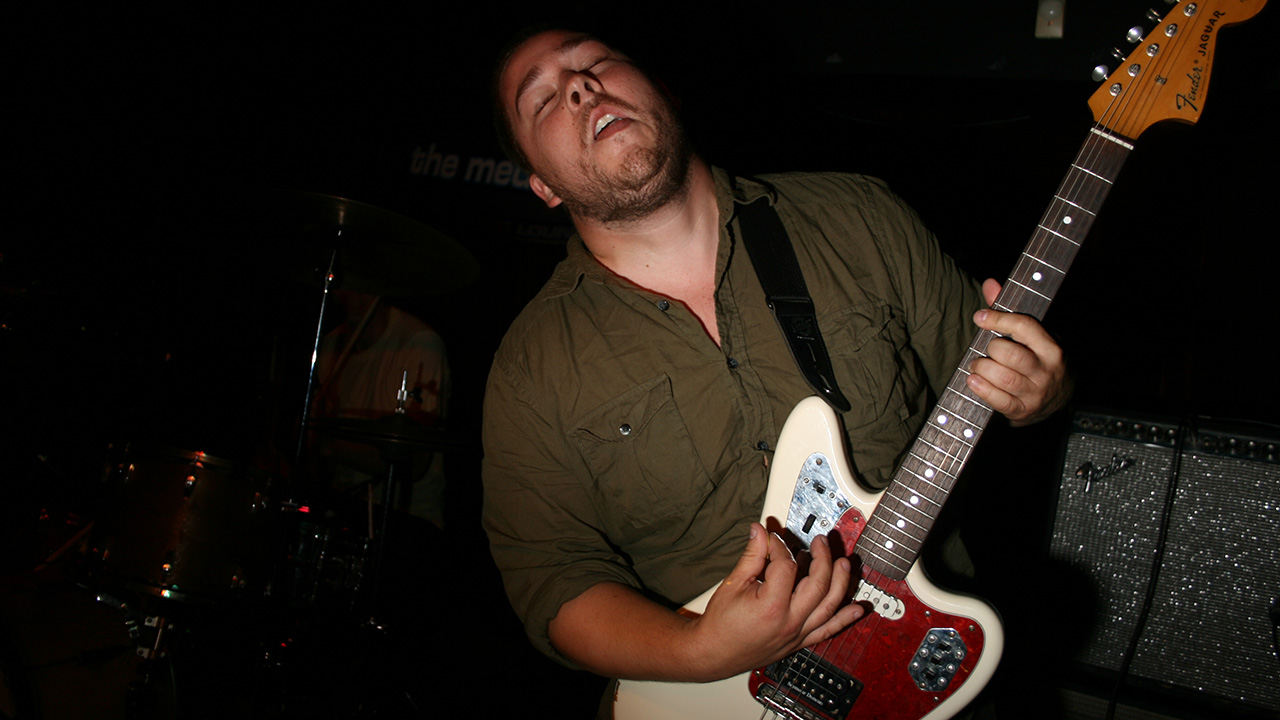“I’ve always loved Fenders. I’m almost working against a design that has been around since the ‘50s – I don’t know if it’s going to cooperate with me”: Pissed Jeans’ Bradley Fry on why he loves awkward offsets and solid-state Peavey amps
The Pennsylvania punks play so loud, Fry gets his sound engineer to mic a tiny Peavey combo instead, so he can keep his onstage amps raging

‘Stability’ isn’t the first word that comes to mind when contemplating Pissed Jeans. Throughout the Pennsylvania punk outfit’s 20-year, six-album career, vocalist Matt Korvette has been barking out tragi-comic character portraits centered on people barely coping with everyday mundanity.
On new album Half Divorced, these include staving off creditors (Sixty-Two Thousand Dollars in Debt) and being terrorized by surprise expenditures (Stolen Catalytic Converter).
As Korvette soars on stage, guitarist Bradley Fry remains determined to hold things down with his Jazzmaster, newly fitted with a set of Planet Waves locking tuners, installed by his guitar tech at Allentown’s Sustain Chapel.
“I’ve always loved using Fenders because of how they kind of don’t work great,” he explains. “The design has been around since the late ‘50s. I’m almost like working against an instrument like that – I don’t know what it’s going to do, or if it’s going to cooperate with me.
“I’ve been having problems with my Jazzmasters because of the long scale. The high E’s been popping out because they’re just those vintage tuners – you put it down the hole, wrap it around and hope that it stays. We put in those locking tuners to hopefully stabilize things when we’re on the road.”
To be fair, part of Fry’s problem might be how he handles Pissed Jeans’ six-string business. The way he hard-fracks into D-standard-set power chording, for instance, sounds as if he’s choking cavernous finger impressions into his fretboard. He lovingly recalls leaping off an amp to elbow-drop the rest of his gear during a raucous show in 2009.
What’s wild is that there’s also a psychedelic grace to Fry’s hammer-on style that betrays the dumbo brutality of his sludgiest riffs. And while Half Divorced is propelled by the band’s most furiously-paced performances yet, its closer Moving On also locks into an iridescently grinning, long-form triplet melody informed by Fry’s love of ‘60s surf music.
All the latest guitar news, interviews, lessons, reviews, deals and more, direct to your inbox!
“It’s weird to have a song that’s A and G, back and forth, for most of it,” he says. “It was kind of different for us, but I hope we can always do something askew from the path we’d normally be on.”
The Moving On video has you playing in front of a coterie of vintage combos. How did you get your start collecting teal-stripe Peavey amps?
“I once worked at a screen-printing shop, and one of the people that worked at the shop was a guy named Mark Cale, who played in a pop-punk band called Weston. He had a Peavey Renown that I purchased from him somewhere around ’95.
We play so loud that I’ll have one quieter amp onstage and tell the sound guys to mic that
“In the ‘90s, we were playing in hardcore bands, probably running a [Boss] Metal Zone through it — scooped mids and all that. I sold the amp to our bass player Randy, who then sold it to our friend Michael, but when we started Pissed Jeans he sold it back to me.
“Those Renowns have stacked mid control, so you can get it to be so mid-focused. They’re also incredibly loud. There’s this guy, Tom Flynn, who played in the band Fang from California. He used Peaveys like that. It just had this monstrous, in-your-face tone. I figured out that the Renown could do that, and I’ve been with them ever since.”
There’s a smaller, cube-sized Peavey in that video too – is it a Rage 158?
“The first amp that I ever purchased was a Rage 158. I used that with a Les Paul-shaped Martin Stinger – I grew up in Nazareth, Pennsylvania, where Martin are based. That amp in the video is actually a Backstage Plus, though. It’s this 30-watt, 10-inch speaker thing that was purchased off Facebook Marketplace.
“I’ve actually been incorporating that live. My thought was that we play so loud that I’ll have one quieter amp onstage and tell the sound guys to mic that, so they’ll leave me alone about my stage volume. It’s kind of funny to have this tiny little Peavey sitting on top!”
How about those beige-wrap Fenders?
“I use Peavey Renowns live, but for recording most of it is a ‘63 Fender Bassman. I think it’s a 6G6-B circuit. It’s the greatest-sounding amp I’ve ever played in my life. It can never go anywhere, though.
“I’m a huge surf guitar guy, so in the Moving On video, you see the Bassman and also a Fender standalone reverb unit. Surf music is also why I got into Jazzmasters and Jaguars. But the Bassman sounds like a Marshall when you turn it all the way up. You throw a boost in front of it and it’s absolutely ferocious. I love that amp a lot.”

You’re oddly Hendrix-ian with the way you use hammer-ons as accents and flourishes. How did you develop that part of your style?
“I’ve never been super-fast with solos, so I think hammer-ons just add some style. It’s no different than bending a note – You’re just adding something more than plucking a note straight. I mean, there’s also an element of Sabbath trills, but used in more of a melodic way.
“Solos are something that I always stress about. They’re either one-take, or I play ‘em forever in the studio, and get frustrated until I finally get it right.”
In our early 20s, what was exciting and creative for us was to slow down. More recently we started to write fast
Your cover of the Pink Lincolns’ Monster has some ripping solo sections on it. How did you go about covering them?
“A band like the Pink Lincolns wasn’t on our radar in the ‘90s – but that song totally rips. Lyrically, it also fits quite well with the rest of our album and what Matt was going for: how humans kind of ruin most things.
“I grew up a hardcore kid, but I also love pop-punk. Bands on Lookout like Screeching Weasel or the Queers – that sort of punk rock with rock-and-roll-y solos.”
Including that cover, Half Divorced feels like a much faster record for Pissed Jeans. How did that affect your technique?
“It was something that grew over time. Before Pissed Jeans, there was a band called the Gatecrashers that we were all in. Just a fast hardcore band, early ‘80s-style – as fast as can be. In our early 20s, what was exciting and creative for us was to slow down.
“More recently we started to write fast. It was like, ‘Let’s just bang out a hardcore record, but thrown through the filter of Pissed Jeans.’ It’s not going to sound like we’re trying to rip off D.C. hardcore or Black Flag. It’s more like, ‘Here’s how we would write a hardcore record in 2023.’
“Some elements are poppy and catchy; some things are weird. Like, the first song on the record – Killing All the Wrong People – is weird, guitar-wise. I’m not doing much. I’m just ringing out. It kind of fits, but it’s not straightforward.”
What guitars did you use on this record?
“I generally bring everything I’ve got to the studio, and things get peppered in here and there. I used that Jazzmaster a lot. There is a Curtis Novak Wide range humbucker fit for Jazzmasters that I just absolutely adore.
”It’s probably my favorite pickup. You get that humbucker sound, but you also have that Fender twang in there when you play a single string. It’s super-clear. I have those in two different Jazzmasters.
I always wanted a fuzz pedal that had a parametric mid EQ built into it
“I also have a ‘90s Japanese Jaguar that I think has a Seymour Duncan Super Distortion in it. I bought it off eBay modded that way, but I’ve never opened it up, so I have no clue overall. The neck on that thing is perfect for me. That’s used on Moving On – It ended up being subtler than the Jazzmaster, which was hot.
“The GCI that I have has P-90s in it, and I used that with those Fender mini-Tonemaster amps – the ones that are super tiny and battery-powered. That’s used a bunch for accents; it sounds so great.
“When we did Why Love Now in 2017, we did something similar with the Gorilla. Like, ‘Well, the Gorilla sounds better than this vintage Ampeg Reverberocket that’s worth way more.”
How did you end up collaborating with Dirty Haggard Audio on your Fuzz Without Emotion pedal?
“Nick Rogers [Dirty Haggard engineer] did this pedal called the Tone Benzer, which is a mix of silicon and germanium transistors in a fuzz pedal. It’s like a Tone Bender, but it’s got a burliness to it – a little more low-end and gain. I bought that and really liked it. I posted something about it, and he got in touch.
“Going back to the Peavey Renown with that mid-stacked sort of feel, I always wanted a fuzz pedal that had a parametric mid EQ built into it. So we did the Fuzz Without Emotion almost like a Tone Benzer, but with that mid EQ.
I don’t know how to build a pedal and I don’t know how to solder, so I would just buy crap
“It can go from super-honky mids – almost like you can’t even listen to it – to super-scooped, and then all the frequencies in between. It’s really fun to play with.”
Junktime sounds unruly and improv-based, and by the end of your lead it sounds like your tubes are full-on dying. What’s going on?
“Do you know the Build Your Own Clone site? They used to have a messageboard in the late ‘00s where you could buy stuff cheap. I don’t know how to build a pedal and I don’t know how to solder, so I would just buy crap that people had on there.
“I bought a Green Ringer clone that somebody put in an old Crayola tin. I used to play it live, but it was ready to fall apart; I’ve had it rehoused since then. I love using a Green Ringer and blending it with a little edge of breakup from the amp – it just has this real messed-up sound. Junktime is that, with slap-back delay.
”Over the past couple of years I discovered a guitar player named Jim Campilongo – he’s kind of a bluesy/country guy. Theres one song by him where he’s playing in E, and then drops down his low E to an octave below. His music’s not normally heavy, but that part in the heaviest frickin’ thing you’ve ever heard. I don’t know why… it’s just him playing straight through a Princeton.
I’m really just trying to entertain myself while I’m playing
“So there’s the influence in Junktime of taking a string, tuning it down mid-song, and trying to bring it back up to find the original key. There’s a part in the ending where I’m hitting an open note and it almost sounds like I’m diving down on the trem-bar, but I’m really just dropping down on the tuning pegs, trying to entertain myself while I’m playing.”
Is that part going to sound extra choice live now, because of the peg upgrades on the Jazzmaster?
“Well, I hope so, since I just had them done!”
- Half Divorced is out now via Sub Pop.
Gregory Adams is a Vancouver-based arts reporter. From metal legends to emerging pop icons to the best of the basement circuit, he’s interviewed musicians across countless genres for nearly two decades, most recently with Guitar World, Bass Player, Revolver, and more – as well as through his independent newsletter, Gut Feeling. This all still blows his mind. He’s a guitar player, generally bouncing hardcore riffs off his ’52 Tele reissue and a dinged-up SG.





